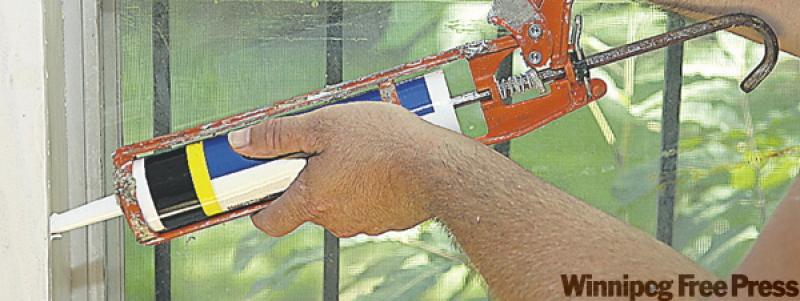Weatherproofing means keeping the weather -- wet, cold or heat and humidity -- on the outside of your home. That covers water possibly coming in through your roof and flashing or through bad mortar joints in your brickwork, as well as air leakage. Wet coming in can cause a lot of costly damage, but usually you find out about it quickly and can fix the problem. Air infiltration is more difficult to spot, and can cost even more in wasted energy.
Many people think of weatherproofing as something you do to get your home ready for winter. But air infiltration is a problem in the summer too. In hot weather, conditioned (cooled) air can still escape, and hot outside air can creep in. Air infiltration is energy wasting year round.
Now that the weather is above freezing it's easier to check and fix your weatherproofing. If you leave it until fall, it'll be too late -- you'll have forgotten where the drafts are that you felt all winter. Also, if you need to remove doors it's better to do it now than in December.
Air infiltration or ventilation?
Ventilation is essential for good indoor air quality. The air in your home should change completely once every few hours in order to remove excess moisture that builds up in your home through washing, showering and breathing. If it doesn't escape, it can contribute to mould growth.
Air infiltration is air leakage -- and it costs money. It's easy to find a draft coming in through a window or door that's been poorly sealed. But it's the air loss you don't notice -- like cold air leaking into your home in winter through a crawl space or attic, or air-conditioned air sneaking out in summer -- that can really add up.
The volume of air in your house always stays the same. So, if the conditioned (heated or cooled) indoor air is leaking out somewhere, it's being replaced by non-conditioned air, and your HVAC system is working overtime to keep the temperature constant.
Air infiltration causes the air to be changed in your home more times than the recommended amount -- which causes more energy to be consumed, and wear and tear on furnaces and AC units. If you properly seal your home -- not even adding more insulation -- you can save hundreds of dollars a year.
How to know if you have leakage
Odds are, your home has some air leakage. Apart from drafts you might feel on a cold, windy day, you can find evidence in the insulation in your attic or behind walls. If it's dirty, you know you have air movement.
Batt insulation isn't a vapour barrier. What it will do is act as a filter -- that's why you see dirty insulation -- but it won't block air movement.
The most common spots for air infiltration are windows and doors, as well as any direct vents to the exterior, like extraction fans, dryer vents, and vent stacks that lead into uninsulated areas like attics. One way to detect air leaks is to use a stick of incense near the suspect areas. The incense smoke will indicate air movement.
Check your windows and doors to see if you need new weatherstripping. You should also remove the trims and casing and make sure there is enough insulation.
If you have drafts near your chimney, firebox, flue or furnace vents you must use a special product that's rated for high temperature. Standard spray foam or caulk is flammable.
Check your television cable jacks, telephone lines, dryer vents, behind electrical outlets and switch plates, plumbing stacks -- any point where conditioned air might escape. The goal is to restrict the air from flowing freely in and out of your home. Spray foam insulation will fill small gaps and voids around windows, doors or vents. It's easy to use -- maybe too easy. Since it expands on contact people use too much around a window and actually put it out of alignment.
Caulk can be used to seal gaps that are less than 1/2 inch (1.3 cm) wide. Make sure you use the right grade and type. Depending on the area that is being caulked, there are products for interior, exterior, low and high temperature use. Some of the factors to consider when choosing the right caulk are flexibility, durability, whether it can be painted, temperature, water resistance and price. Caulking is engineered for different purposes and what might be great for sealing around your windows isn't what should be used around your shower door.
Backer rod is like rope caulk and is basically just pressed into a crack with a screwdriver or a putty knife. Builders and contractors should use it along with caulk around windows and doors.
Weatherproofing really comes down to properly sealing any cracks and joins where air and water can penetrate and damage your home.
If you don't know what you're doing, I recommend bringing in someone who does. If anything, exceed the basic standards if you want your home to be completely weatherproofed.
Watch Mike Holmes take on the biggest challenge of his career in Holmes in New Orleans on HGTV Thursdays at 8 p.m. ET/PT. Visit www.hgtv.ca/neworleans for more information.
-- Canwest News Service




